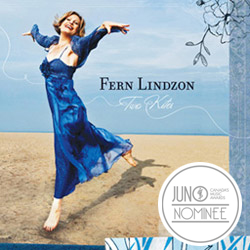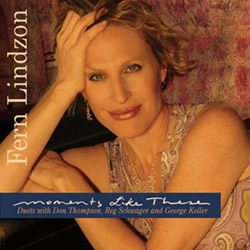by Michael Posner, The Globe and Mail, April 2, 2008
Inspired by Ella
Fern Lindzon was on her way to becoming a classical pianist until she unexpectedly fell in love with jazz. Now, she’s one of Toronto’s most popular performers
When Fern Lindzon was eight years old, her mother, Toronto artist Rose Lindzon, started piano lessons. “I used to lie in my bed listening to her play,” Lindzon recalled, “and by the time I was 9, I was really champing at the bit to learn.” About a year later, her mother abandoned her adult avocation (although she had already made it to Grade 5), and daughter Fern began. She has never really stopped.
Now, four decades and a long musical journey later, she’s releasing her debut CD, Moments Like These, a compilation with three jazz heavyweights – bassist George Koller, Don Thompson on vibes and guitarist Reg Schwager.
Former Globe and Mail jazz writer Mark Miller, a critic careful with his praise, describes Lindzon on her website as “an engaging pianist and singer who brings an unassuming authority, an inquiring spirit and a natural grace to contemporary jazz.”
The album includes standards (On the Street Where You Live and Where Do You Start?); tenor saxophonist Wayne Shorter’s To See Through Infant Eyes, for which Lindzon wrote, with his permission, the lyrics; the haunting ballad Re’i, written by a mixed Israeli/Muslim band called Sheva; a klezmer take on a Thelonius Monk-like tune called You Really Shouldn’t,But; and Tr7, a bluesy Lindzon composition using Schoenberg’s 12-tone row. It has been a particularly busy and satisfying year for Lindzon. She has appeared on two other CD releases, one self-titled effort by the klezmer group the Lithuanian Empire, and another, Sheynville Express, by the Sisters of
Sheynville, a sextet whose work is a fusion of swing, klezmer and Yiddish. The reviews for work on those albums have been glowing.
This month, she has numerous Toronto gigs, starting with an appearance with Koller this evening at the Rex Hotel (the first of four dates there), followed by a klezmer brunch on April 13 at the Free Times Café with the Yiddish Swingtet, and a Sisters of Sheynville gig at the Gladstone Hotel on April 17. She’s scheduled to perform and sign CDs at Toronto’s Manulife Centre Indigo store on the evening of April 10.
And though she says she’s less active than she used to be, Lindzon remains a formidable Scrabble player, plays regularly at the Toronto Scrabble Club, the oldest of its kind in North America, and was once the top-ranked female Scrabble player in Canada. “It’s not so much about vocabulary,” she says of her talent for the game, as it is a perceptual ability to see the board and its possibilities. Her April calendar also includes two nights as a volunteer at Scrabble fundraisers, where players pay $50 for tips from Lindzon.
Trained as a classical pianist, Lindzon studied music history at the University of Toronto, specializing in 20th-century works. She concedes that she never had any particular affinity for jazz until one night, in her late teens, she and a girlfriend stumbled into a jazz club (in pursuit of a young man) and heard a combo that included pianist Ted Moses and guitarist Lorne Lofsky.
“I’d never heard music like that,’ Lindzon recalled during a recent interview. “And I immediately thought, this is what I really want to be doing.” Her instincts were confirmed when she heard Ella Fitzgerald’s 1973 album of duets with Joe Pass, Take Love Easy.
She started studying jazz, going to clubs and buying jazz albums. Then, to clear her head, she took a year off and went to Israel, spending nine months on a kibbutz in the Jezreel Valley. When she returned, she plunged headlong back into jazz, studying both piano and voice – a dramatic change from the classical lieder she had previously sung. She spent three years studying with the multi-instrumental Don Thompson.
“Don was great,” Lindzon says. “The thing about Don is, he doesn’t have an agenda. He knows how to work with whatever you bring. I remember one of the first things he said was, ‘From now on you’ll never play another note that doesn’t mean anything.’ And at the time, I was playing a lot of piano bars and that can be very damaging, if you go on automatic pilot.”
For years, while raising two children, Lindzon played and organized music for corporate and organizational events. It was only about three years ago, she says, that she decided to raise her personal bar. “It was around the time of my birthday and I just thought, ‘Well, it’s now or never, in terms of really performing. I’m not going to say no to anything.’ ”
A few weeks later, she was playing and singing around town at Ben Wicks jazz club and soon after at the Montreal Bistro, the Rex and other venues. She hasn’t looked back.
The album’s title alludes to the seminal musical moments that have shaped her life, including, at the age of 9, only a few weeks after she started piano lessons, hearing Arthur Rubinstein play Chopin at Massey Hall. “This seemingly ancient man, whose unbounded energy and passion scared me to death. I thought for sure he would have a heart attack and I would have to replace him.” Such moments, she says, “make sense of our life, create euphoria, open a doorway, make us feel like we’ve come home.”
 On pianist/vocalist/composer Fern Lindzon’s sophomore recording, she explores themes of spiritual and emotional transcendence as well as the kinaesthetic experience of soaring through, around and above the natural elements of wind, sea and sky. The musical journey is an eclectic one, featuring original material, Brazilian and Yiddish compositions as well as blues and a medley of Broadway standards – even so, there is a unifying creative intent on this breathtakingly beautiful album. For “Two Kites” she has enlisted gifted collaborators bassist George Koller (who also wears the producer hat), Mike Murley on saxophones and Nick Fraser on drums.
On pianist/vocalist/composer Fern Lindzon’s sophomore recording, she explores themes of spiritual and emotional transcendence as well as the kinaesthetic experience of soaring through, around and above the natural elements of wind, sea and sky. The musical journey is an eclectic one, featuring original material, Brazilian and Yiddish compositions as well as blues and a medley of Broadway standards – even so, there is a unifying creative intent on this breathtakingly beautiful album. For “Two Kites” she has enlisted gifted collaborators bassist George Koller (who also wears the producer hat), Mike Murley on saxophones and Nick Fraser on drums. by Tracey Nolan, Coda Magazine, May 2008
by Tracey Nolan, Coda Magazine, May 2008